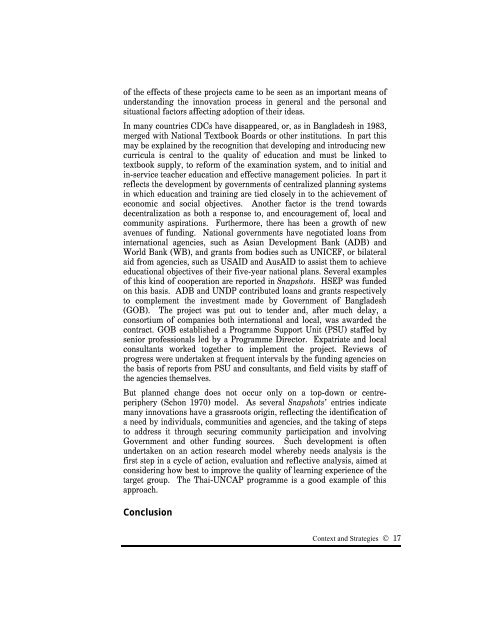Download PDF, 752KB - UNESCO Bangkok
Download PDF, 752KB - UNESCO Bangkok
Download PDF, 752KB - UNESCO Bangkok
Create successful ePaper yourself
Turn your PDF publications into a flip-book with our unique Google optimized e-Paper software.
of the effects of these projects came to be seen as an important means ofunderstanding the innovation process in general and the personal andsituational factors affecting adoption of their ideas.In many countries CDCs have disappeared, or, as in Bangladesh in 1983,merged with National Textbook Boards or other institutions. In part thismay be explained by the recognition that developing and introducing newcurricula is central to the quality of education and must be linked totextbook supply, to reform of the examination system, and to initial andin-service teacher education and effective management policies. In part itreflects the development by governments of centralized planning systemsin which education and training are tied closely in to the achievement ofeconomic and social objectives. Another factor is the trend towardsdecentralization as both a response to, and encouragement of, local andcommunity aspirations. Furthermore, there has been a growth of newavenues of funding. National governments have negotiated loans frominternational agencies, such as Asian Development Bank (ADB) andWorld Bank (WB), and grants from bodies such as UNICEF, or bilateralaid from agencies, such as USAID and AusAID to assist them to achieveeducational objectives of their five-year national plans. Several examplesof this kind of cooperation are reported in Snapshots. HSEP was fundedon this basis. ADB and UNDP contributed loans and grants respectivelyto complement the investment made by Government of Bangladesh(GOB). The project was put out to tender and, after much delay, aconsortium of companies both international and local, was awarded thecontract. GOB established a Programme Support Unit (PSU) staffed bysenior professionals led by a Programme Director. Expatriate and localconsultants worked together to implement the project. Reviews ofprogress were undertaken at frequent intervals by the funding agencies onthe basis of reports from PSU and consultants, and field visits by staff ofthe agencies themselves.But planned change does not occur only on a top-down or centreperiphery(Schon 1970) model. As several Snapshots’ entries indicatemany innovations have a grassroots origin, reflecting the identification ofa need by individuals, communities and agencies, and the taking of stepsto address it through securing community participation and involvingGovernment and other funding sources. Such development is oftenundertaken on an action research model whereby needs analysis is thefirst step in a cycle of action, evaluation and reflective analysis, aimed atconsidering how best to improve the quality of learning experience of thetarget group. The Thai-UNCAP programme is a good example of thisapproach.ConclusionContext and Strategies © 17
















